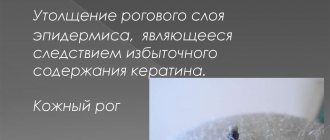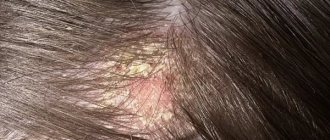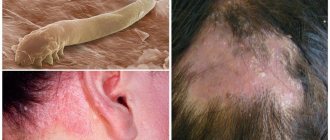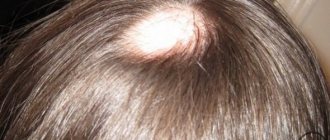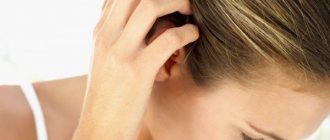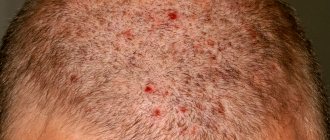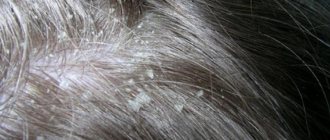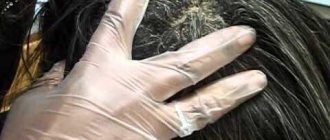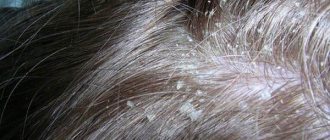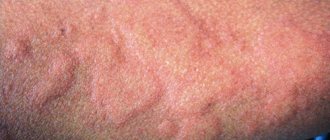Oily seborrhea
Oily seborrhea is a disease that occurs due to dysfunction of the sebaceous glands and a pathological increase in their activity.
All the features of this disease are given below:
- Men over 30 years of age are at risk. The causative agent is a specific type of yeast fungus, but the disease can also be triggered by prolonged experience of stressful situations, a tendency towards increased oiliness of the skin, the presence of endocrine diseases, lack of vitamins, impaired metabolism, poor heredity or lack of proper hair care.
- The main symptom is the presence of an unhealthy oily sheen, due to which the hairstyle always seems dirty or damp. Even after washing, a rapid formation of yellowish oily dandruff is observed, which sticks the strands together. There is also a thick form of oily seborrhea, which is characterized by an increase in the rigidity of the hairline and a deterioration in its elasticity.
- Antifungal shampoos are used for treatment, but this measure alone is not enough. It will be necessary to carry out diagnostics and find out the main causes of this disease, which will prevent possible relapses.
- Effective prevention is following the rules and regulations of personal hygiene, choosing the right products for washing your hair, giving up bad habits and leading a healthy lifestyle, ensuring a balanced and nutritious diet, maintaining the immune system in good condition and taking preventive vitamin complexes.
Dry seborrhea
Dry seborrhea occurs for the same reasons as the oily variety, but this disease has its own individual characteristics:
- The main symptom is severe drying of the skin, which leads to flaking of the scalp and the appearance of a large amount of dandruff; its color may vary. Against the background of dandruff formation, severe itching gradually begins to be felt and a general deterioration in the condition of the hair is observed.
- To treat dry seborrhea, complex therapy is used, which will consist of the use of antifungal drugs and shampoos with a moisturizing effect to restore water balance. At the discretion of the specialist, physiotherapeutic procedures may be prescribed, including cryotherapy, mesotherapy or cryomassage. In the most advanced and complex situations, hormonal-type pharmacological medications and medications with high levels of zinc are prescribed.
- Preventive measures are exactly the same as for oily seborrhea.
What to do if you find yourself with one of the symptoms?
Listed above are only the most common types of scalp diseases, but there are dozens of others - less common, but no less unpleasant problems. The main catch in the treatment of scalp diseases is mimicry. Skin diseases “disguise” as each other, because In addition to completely advanced and therefore pronounced cases, they have a number of common symptoms that make diagnosis difficult. What’s even worse is that diseases of related categories begin almost the same way, and a person may simply not notice the impending threat. Instead of treatment, he turns to a cosmetologist, who unsuccessfully tries to correct the situation, only triggering the disease.
For proper treatment, it is necessary to determine the type of scalp disease as accurately as possible. And for an accurate diagnosis of diseases, modern diagnostic equipment is required, which not every specialist has. At the Clauderer Trichology Center you can count on a full range of computerized equipment and related services - from therapy to the preparation of preparations for individual hair treatment.
Psoriasis
The situation with psoriasis is much more complicated, since this disease, although it does not pose a threat to human life, often goes into a chronic phase and disrupts the aesthetic appearance.
All its main features are discussed in more detail below:
- There are different forms of psoriasis, but the main symptom is always the appearance of noticeable patches covered with easily detachable scales, which are usually grayish or white in color.
- Factors that can provoke this disease are: excessive increase in load on the central nervous system; dietary disorders; previous injuries; frequent hypothermia; tendency to an allergic reaction and its exacerbation.
- In the initial stages, psoriasis can be cured by treating the affected areas with various ointments, which include one of the following components: salicylic acid, zinc oxide or tar. In all other cases, specialists prescribe potent pharmacological drugs for oral administration. Drug therapy usually includes sedatives, corticosteroids and vitamin complexes.
Ringworm
Ringworm is an infectious disease that affects the scalp and is caused by a specific type of fungus.
Symptoms, causes and methods of getting rid of the disease are described below:
- Infection most often occurs through direct contact with infected warm-blooded animals, people or their personal hygiene items.
- Factors that increase the risk of infection: lack of vitamin A in the body, systematic contact with an infected person, failure to comply with personal hygiene rules, poor immune system condition and the presence of serious damage to the skin.
- The incubation period is no more than 3-4 days, after which the main symptoms begin to be observed: the appearance of characteristic spots in the form of rings of a reddish or pinkish color, while a feeling of itching is felt in the affected areas.
- When the first signs of the disease appear, urgent action is necessary, since otherwise the disease may become chronic. Therapy usually consists of oral medications with antifungal components, such as Lamisil, as well as topical treatment. Sulfur-tar ointments, alcohol solutions of iodine and preparations containing salicylic acid show a high degree of effectiveness. Often, additional treatment of affected hair is required, following a diet and taking vitamin and mineral complexes that can improve the immune system and the body’s natural resistance.
Microsporia
Microsporia is another fungal disease that simultaneously affects the skin and scalp, and in the most severe cases, also the nail plates.
All the features of the course and treatment of this disease are given below:
- Children aged 5-12 years are at risk; microsporia occurs in adults only in rare cases. This is due to the high level of concentration of organic acids in the hair, which does not allow the pathogenic fungus to actively multiply.
- The lesions from which the lesions spread are most often located on the crown or temples. Their size is usually no more than 2-5 cm, and the borders have clear, rounded outlines. The first symptom is peeling of the skin in the affected areas, but after a week the fungus also affects the hair, which becomes too brittle and begins to fall out after numerous mechanical damages. Sometimes there are forms of microscopy in which swelling and inflammatory processes of a purulent type occur, which is why soft blue-red nodes appear on the head.
- To treat microsporia, 5% tincture of iodine is usually used, as well as various ointments containing salicylic acid, tar or sulfur. The specifics of therapy depend on the form of the disease and the specifics of its course; oral antibiotics are often additionally prescribed.
Pustular diseases of the scalp, or pyoderma
They constitute a large group of diverse head lesions caused by various microorganisms. The latter are present on the surface of the skin or are brought into it from other foci of infection. These pathogens often include Staphylococcus aureus, less often - streptococci of groups “A”, “C”, “F”, pyogenic (pyogenic) streptococci or their association with Pseudomonas aeruginosa, Escherichia coli, Proteus and other types of pathogenic microorganisms.
Pustular diseases of the head can occur independently with low general or local skin immunity, especially with endocrine disorders and diabetes mellitus. However, they are often a complication of seborrhea, eczema, psoriasis, and fungal infections, in which there are all the conditions for the rapid reproduction and development of bacteria.
Eczema
Eczema comes in many different forms, with the scalp usually affected by the seborrheic variety.
All the features of this disease are discussed in detail below:
- The main symptom of eczema is the formation of characteristic yellowish plaques; they can have very different sizes. When the scalp is affected, hair loss occurs, the plaques gradually become covered with a dry crust, which soon begins to peel off.
- Even seborrheic eczema rarely affects only one head; lesions also affect the entire face, armpit area and genitals.
- A variety of factors can provoke the occurrence of the disease, including prolonged and frequent exposure to ultraviolet rays, disruption of the functioning of the kidneys or digestive system, the presence of parasites in the body, an allergic reaction or side effects of various pharmacological drugs.
- Therapy is prescribed depending on the causes of eczema. Often, taking hormonal medications and vitamin complexes is required; in the presence of parasites or dangerous microorganisms, antimicrobial and antiparasitic drugs are prescribed. Immunomodulators and enterosorbents also show high effectiveness.
Brief description of the most common pathology
Seborrhea
This scalp dermatosis is a disease of the scalp, the most characteristic symptom of which is a disorder in the formation of sebum. It can be expressed both in a violation of the amount of its production, and in a change in the chemical composition.
In a normal state, after secretion by the sebaceous glands, fat fills the ducts of the hair follicles, mixes with sweat, emulsifies and is distributed along the skin grooves over almost the entire surface of the scalp. As a result, an emulsion water-lipid film is formed, which provides a certain acidic environment and performs protective functions: preventing the excessive negative effects of ultraviolet rays, drying and waterlogging of the skin, and exposure to chemical elements of the external environment.
Insufficient sebum production does not provide full protection, which leads to dryness and increased vulnerability.
Hyperfunction of the sebaceous glands creates a greenhouse effect, as a result of which the stratum corneum softens, its porosity increases and permeability increases. Due to the expansion of the excretory ducts of the sebaceous and sweat glands, bacteria, masses of separated epithelium and dirt penetrate into them more easily, and plugs are formed that clog the mouths of the hair follicles.
For more information about what seborrhea of the scalp is, watch the video:
In addition, with seborrhea, not only disturbances in the secretion of sebum occur, but also its qualitative changes. For example, the ratio of fatty acids changes - the concentration of linoleic acid decreases significantly, resulting in increased acidity on the skin surface. This further increases the permeability of the stratum corneum and causes irritation.
Such conditions are ideal for the activation and development of saprophytic fungi on the scalp, the reproduction and growth of staphylococci and other infectious pathogens, which are representatives of the normal microflora on the surface of the scalp. Microorganisms cause damage to the walls of the skin glands and their ducts, secrete the enzyme lipase, which breaks down triglycerides of sebum into free fatty acids, and the latter, in turn, increase skin irritation and reduce its protective functions.
All these mechanisms contribute to increased severity of scalp seborrhea, the formation of seborrheic dermatitis and eczema. There are three forms of seborrhea:
- fat;
- dry;
- mixed.
Oily seborrhea
Depending on the composition and physicochemical properties of the sebum on the scalp, it can be liquid or thick. In the first case, the fat has a liquid, oily consistency due to the increased concentration of free fatty acids. In its thick form, the consistency of the fat is doughy.
The disease manifests itself in changes in the scalp: it becomes shiny, thickened, elasticity is reduced, the pores are enlarged, and its color acquires a brownish or yellowish-gray tint. The hair becomes greasy, shiny, sticks together in strands, and quickly, 2-3 days after washing your hair, becomes covered with dirt. Particles of desquamated epithelium (dandruff) stick together into plates and form fairly large scales of a yellowish color, with which the hair is abundantly covered.
These symptoms are accompanied by itching of the scalp, sometimes severe. Frequent washing is ineffective and provokes an even greater increase in the function of the sebaceous glands and contamination of the hair on the head.
Dry seborrhea
This scalp disease is accompanied by such basic subjective symptoms as slight itching of the skin and a feeling of tightness, especially after washing the hair with cool water.
With this form of seborrhea, a decrease in the function of the sebaceous glands is possible, which usually occurs in children before puberty. It is mainly associated with insufficient development of the pilosebaceous apparatus. In adults, the function of the skin glands is usually preserved, but their secretion has a high degree of viscosity and is poorly distributed over the scalp.
As a result, the superficial epidermal layers become dry, the skin becomes hypersensitive and susceptible to the influence of even minor irritants. The horny epithelium in the form of small scales covers all the hair on the head. Less commonly, they layer on top of each other, forming grayish and yellowish plates and crusts. Peeling develops over the entire surface of the scalp or only in the parietal-occipital zone.
Due to dryness, hair becomes thin with split ends and brittle. Reddish or pinkish patches (seborrhoids) may form on the scalp. Increased hair loss is often observed.
Sometimes dry seborrhea is unexpressed and is accompanied only by moderate dryness and somewhat increased flaking, reminiscent of dandruff.
Mixed form of seborrhea
Sometimes it is difficult to distinguish and is a combination of manifestations of both previous variants of the disease or their combination with localization on the head and other parts of the body.
Seborrheic dermatitis
Seborrheic dermatitis, or eczema, and dandruff
Seborrheic dermatitis is considered an independent dermatosis, and according to some experts, a complication of seborrhea. The occurrence of pathology is predisposed by the presence of one or another form of seborrhea, various endocrine disorders accompanying it, as well as factors that provoke the development of seborrhea. A milder form of seborrheic dermatitis is dandruff on the head, which occurs as a result of a pathologically accelerated process of cellular regeneration of the epithelium.
If normally the transformation of basal keratinocytes and their rise to the stratum corneum occurs on average within 25-30 days, then with seborrheic dermatitis this lasts only about 1-2 weeks.
Small whitish cells of the dead epithelium are separated prematurely. Many of them do not have time to lose water and stick together, forming small whitish or grayish flaky scales, which are dandruff. In this case, the number of layers of the horny epithelium is reduced by more than half, and the layers themselves and the cells in them are not located tightly to each other, but loosely and chaotically.
Seborrheic dermatitis primarily affects the scalp and, to a lesser extent, other areas of the body. The disease occurs chronically and over a long period of time. The main cause of exacerbations is most often stress and mental fatigue.
Characteristic symptoms of this scalp disease:
- dry scalp;
- areas of redness;
- pityriasis peeling;
- serous-purulent and serous-hemorrhagic (bloody) crusts. If they are removed, a solid pinkish, weeping lesion on the skin surface is exposed.
When lesions appear in the area behind the ear, significant redness with swelling develops, deep painful cracks, weeping and scales with crusts form in the skin folds.
Psoriasis
Scalp psoriasis
This scalp disease is chronic and periodically relapsing. It manifests itself as specific papular rashes on the head of a pinkish-reddish color, on which easily removable silvery scales are located. The lesions consist of plaques with clear boundaries and irregular, bizarre outlines. Their size ranges from 1-2 mm to 1-2 cm or more.
Scalp psoriasis can be hereditary, i.e. due to genetic reasons, or acquired mainly due to dysfunction of the liver, endocrine or nervous system. Exacerbations are facilitated by unfavorable climatic conditions, digestive dysfunction, and mental stress.
The disease is considered incurable, but it is quite possible to reduce the frequency and severity of exacerbations, as well as eliminate the consequences.
Mycoses, or fungal diseases of the scalp
Mycoses of the scalp are caused by pathogenic fungi. More often they affect children and young women, much less often - men. These scalp diseases are infectious and are transmitted from sick animals or from a sick person when using common hygiene and hair care items (combs, underwear, towels, hats). Symptoms of fungal diseases of the scalp vary and depend on the infectious pathogen.
These lesions include:
- favus;
- microsporia;
- trichophytosis.
Favus
Favus, or scalp scab
The causative agent of the head disease is highly resistant in the external environment and is capable of existing for a long time, without losing its activity, in the dust of residential premises, carpets, and furniture. Infection occurs through direct contact or as a result of using contaminated objects.
The disease manifests itself as peculiar crusts on the scalp, from which an unpleasant odor emanates. They look like saucer-shaped shields with a depression in the central part. The crusts are often riddled with hair. The latter take on a dull appearance and resemble a dusty wig. The crusts tend to merge, and the hair roots underneath them atrophy. The hair itself is not subject to breakage, but is easily removed. Persistent focal baldness of the head develops.
The affected areas on the head are sometimes covered with pityriasis-like small scales, and on the smooth areas purulent or yellowish-brown crusts are formed, in the center of which there are vellus hairs.
Microphytia
Microsporia of the head
This scalp disease is caused by a fungus transmitted through contact with sick pets or a sick person, and is infectious. Foci of pityriasis-like skin peeling with clear boundaries appear on the scalp, accompanied by itching. Hair in the area of lesions on the head breaks off at a distance of 5-7 mm from the surface of the scalp, is covered with a whitish film and has a dull grayish color.
Trichophytosis. Infiltrative-suppurative form
Trichophytosis
Another name for it is “ringworm” of the head. It is transmitted through direct contact with sick dogs or cats, as well as through things belonging to a sick person. It can be superficial, which most often affects teenage children, or deep, affecting mainly young people. The superficial form is manifested by small rounded lesions on the head, in the area of which the hair is broken off at varying heights from the skin surface. Their occurrence is accompanied by itching and peeling of the epithelium of the head.
The deep form of the head disease is characterized by small rounded areas of complete baldness. At the border of the lesions, suppuration of the hair follicles occurs, accompanied by an unpleasant sweetish odor. Along the edges of the lesions, hair on the scalp is easily removed, and the remaining areas of the scalp are covered with multiple crusts.
Pediculosis
Pediculosis is an infection caused by the most common type of parasite - lice. They can live in bedding or infect the hairy area around the genitals, but head lice are the most common.
All features of the course of pediculosis and treatment for it are discussed below:
- The basis of lice's diet is human blood; infection most often occurs through contact with infected people or their personal hygiene items.
- A person usually notices the presence of lice 7-10 days after infection, since nits are not always noticeable and in fact do not reveal their presence in any way. The bites cause severe itching, so scratching soon appears; upon examination, you can find mature parasites and their eggs securely glued to the hair. If left untreated, pediculosis develops into more complex forms, the described symptoms become more noticeable, and the lymph nodes often become enlarged.
- The most common complication is various bacterial infections that enter through damaged scalp. In addition, an infected person can trigger an entire epidemic, since lice are very contagious.
- If lice are detected, you must use a special shampoo, spray or other means to remove them. Usually, several procedures are required, since most modern drugs do not destroy nits and after 7-10 years a new generation of parasites appears. Not only the infected person, but also all members of his family, as well as personal hygiene items, bedding and hats should undergo treatment.
Folliculitis
Folliculitis is a purulent lesion of the skin that can affect not only the head, but also other parts of the body.
The features of this disease are discussed below:
- People living in countries with hot climates or unsanitary conditions are at risk.
- The lesions are located near the hair follicles, and a pustule with pus inside is formed. After opening, a small ulcer remains, which soon becomes covered with a crust consisting of a mixture of blood and pus. It usually takes about a week for complete healing; after peeling off the crust, a scar may remain in its place.
- Treatment is prescribed depending on the form and causes of folliculitis. For bacterial infections, antibiotics are prescribed; for herpetic infections, acyclovir is prescribed; and for fungal infections, special antifungal drugs are prescribed. In more complex cases, potent drugs are prescribed, but at the initial stage it is sufficient to treat the affected areas with green or fucarcin.
Damage to the hair shaft
Injury to the hair shaft occurs very often. Perm, use of heat irons, curling irons, dyeing curls - all this damages the shaft along its entire length.
Mechanical, thermal and chemical aggressive effects do not always provoke excessive hair loss, but become the main cause of increased hair fragility, damage to the ends, dryness, and loss of elasticity.
Hair health also depends on a balanced diet, constant hygiene procedures, ecology, and psycho-emotional background.
Shiny, strong and strong curls are not only external beauty, but also an indicator of internal health.
Trichoclasia
The term trichoclasia refers to increased fragility. The main cause of the anomaly is infections suffered by the mother during pregnancy.
Trichoclasia is divided into two types:
- NODULA TRICHOCLASIA. It manifests itself in the formation of grayish-white nodules on the hair (most often on its lower third).
The spaces between these nodules are not the same. The areas of hair between the nodules do not undergo any changes; longitudinal splitting of the hair shaft can be seen under a microscope only next to the deformation. The hair near the nodules breaks off easily and when examined, you can see a separation at the end of the curl. Not all hair is affected by knots. - ACQUIRED TRICHOCLASIA. Divided into two forms. Proximal is manifested by a lack of curl growth and occurs in African Americans even in childhood. The hair on the head is short, has a longitudinal split and whitish nodules on the shaft.
. The curls break off at the slightest tug. Proper care can lead to restoration of hair structure. The distal form of the disease is manifested by the formation of white nodules with bizarre shapes at the end of the hair. The thinned ends break off at the site of deformation. The anomaly affects a limited amount of hair on the head; in men, the beard may suffer.
Twisted hair
Trichokinesis (twisted hair) - such an anomaly of the shaft first becomes noticeable before the age of two.
With this disease, the hair is coarse, of different lengths, hard, and practically devoid of natural shine. Some children have noticeable patches of alopecia.
The damaged rod has flattened areas and grooves, and bends around its axis at different angles. A weak degree of twisting is most often a variant of the norm.
With pathology, the curls cannot be combed normally; they constantly become tangled and pulled out.
Trichokinesis is found mainly in girls. By about eight years of age, the number of healthy hairs increases, and twisted curls become less noticeable against their background.
Monilethrix
One of the rarest anomalies. Monilethrix appears in the first months of life, affecting not only the scalp, but also eyebrows, eyelashes and other areas with hair.
The disease is characterized by the appearance of thinning and thickening on the hair shaft. Thickened areas look darker on light strands.
.
In areas of thinning, the hair breaks off, and therefore the hair on the head rarely reaches more than one and a half centimeters in length.
With monilethrix, congenital changes in the innervation of the skin are noted, and this causes deformation of the hair follicles.
Gradually, the curls become too dry, thin and break. The disease is accompanied by the development of follicular hyperkeratosis.
